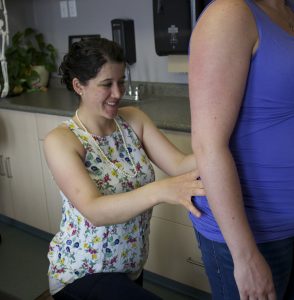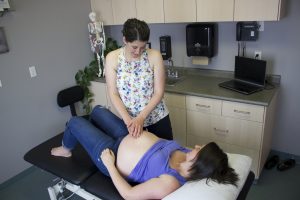At Warman Physio our therapists focus on excellence. Providing excellent, comprehensive, up-to-date care, as well as a personable and compassionate care.
This is why going to courses, reading research, is so important… and being a little bit “nerdy” comes in handy 😉
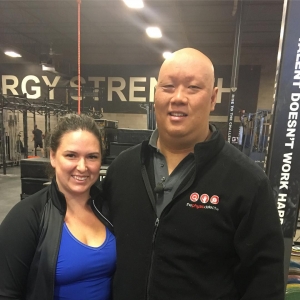
This past weekend I took a course from Antony Lo, an outstanding therapist and physiotherapy educator from Australia, called The Female Athlete. This course was designed to challenge the status quo on current standard practice recommendations for women’s health related to Diastasis Recti, Prenatal, & Postpartum care.
During this course my belief system was challenged in some ways, and affirmed in others. My take-away from this course? First, we need more research in pretty much everything – we have far more questions than we do answers, and although we would like to have specific YES and NO answers for our clients’, everyone is individual with unique needs (not surprised here!) – basically, you are your own person, and the rules may not apply, and may need to be broken in your instance.
Another thing that we need to consider is pain. What is pain exactly?
“Pain is an unpleasant sensory and emotional experience associated with actual or potential tissue damage, or described in terms of such damage”.
What does this mean? Sensory and emotional experience – does anyone find they have more pain when they have more stress? How about if you have pain with something that doesn’t actually 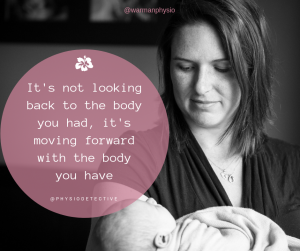 damage your tissue – like when your foot falls asleep and you get the painful pins and needles. We do not need tissue damage for pain, and no matter what is going on, your pain is exactly that, YOUR PAIN. Not the therapist, not your family, yours. No one can tell you that you don’t have pain, because it is your experience alone. Because of this reason, some pain can be resolved and changed very quickly, and some may take longer.
damage your tissue – like when your foot falls asleep and you get the painful pins and needles. We do not need tissue damage for pain, and no matter what is going on, your pain is exactly that, YOUR PAIN. Not the therapist, not your family, yours. No one can tell you that you don’t have pain, because it is your experience alone. Because of this reason, some pain can be resolved and changed very quickly, and some may take longer.
Last, our bodies are extremely strong, capable, adaptive, and resilient (SCAR)! We can change our perspective and make our weaknesses into strengths.
It boils down to WHY is continuing education so important? Why do we at Warman Physio put such an emphasis on continuing education? The answer is that it is our belief that being up to date, learning new information, making sure we are at the forefront of practice changes benefits our clients. We are open to education, views that challenge our current beliefs, and learning something new in expected, as well as unexpected ways. There are more ways than one that I find myself learning not only from colleagues and coworkers, but also from my clients and those I meet in day to day life. The curious mind, and attitude of intrigue, and being able to take new information and integrate it into practice is something that at Warman Physio we are striving for, not just on weekends we are learning formally, but every single day!
Do you think this is AMAZING? Have some questions? Want to tell me how it resonates with you? Send me a message!

 Haylie has been practicing women’s health and focused in prenatal and post-partum care since graduating from the U of S MPT program in 2011. Adding to her practice pediatric pelvic floor therapy in 2017. She has been advocating for treatment for women, ensuring appropriate and effective care throughout pregnancy and post-partum, and helping all expecting and post-partum moms brought her to open her family-friendly clinic; where clients are encouraged to bring their infants and children to treatment. Warman Physiotherapy & Wellness has been nominated for the 2018 WMBEXA, is a WMBEXA award recipient of 2017, and a finalist in the ABEX 2016, 2017, & 2018. Haylie was also recognized as YWCA Women of Distinction for Health & Wellness in 2017.
Haylie has been practicing women’s health and focused in prenatal and post-partum care since graduating from the U of S MPT program in 2011. Adding to her practice pediatric pelvic floor therapy in 2017. She has been advocating for treatment for women, ensuring appropriate and effective care throughout pregnancy and post-partum, and helping all expecting and post-partum moms brought her to open her family-friendly clinic; where clients are encouraged to bring their infants and children to treatment. Warman Physiotherapy & Wellness has been nominated for the 2018 WMBEXA, is a WMBEXA award recipient of 2017, and a finalist in the ABEX 2016, 2017, & 2018. Haylie was also recognized as YWCA Women of Distinction for Health & Wellness in 2017. 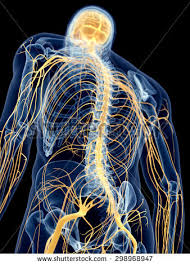 Globally with pain science, one of the most important things to understand are there are no pain signals to the brain. The brain receives information from the body, and depending on what all those signals are saying, will determine if something is painful or not. Have you ever stubbed your toe when you are having a great day? It hurts SO MUCH. But, if you stub your toe while you are in the middle of an argument with someone, it doesn’t hurt the same; that’s pain science!
Globally with pain science, one of the most important things to understand are there are no pain signals to the brain. The brain receives information from the body, and depending on what all those signals are saying, will determine if something is painful or not. Have you ever stubbed your toe when you are having a great day? It hurts SO MUCH. But, if you stub your toe while you are in the middle of an argument with someone, it doesn’t hurt the same; that’s pain science!



